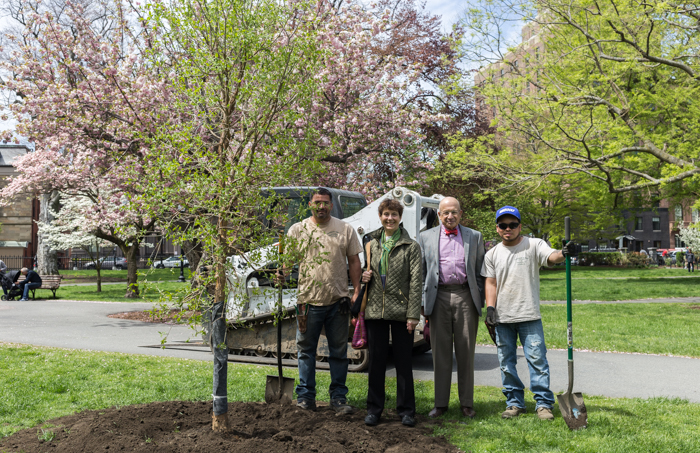
Tree sponsors Beatrice and Peter Nessen pose next to the Chinese fringe tree in the Public Garden
THE FRINGE TREE
The fringe tree is a spring-flowering deciduous ornamental tree that has not yet attained the popularity of the more common dogwoods, magnolias and flowering cherries. Since the fringe tree is tougher than the dogwood, more dependable than magnolias, longer-lived than the cherry, and a beautiful tree, maybe its time has come!
The fringe tree gets its name from the fragrant, airy, drooping clusters of fringe-like white petals. The flower clusters of both the American and Chinese types cover the entire tree in a beautiful display, looking like tufts of fleece. Both species can be either male or female, known as dioecious, with male flowers showier than the female. However, the pollinated female flowers form attractive blackish-blue fruits in late summer that are a food source for birds and wildlife.
American Fringe Tree (Chionanthus virginicus)
The American fringe tree grows 12 to 20 feet tall and wide, indigenous to the eastern U.S and flourishes from Canada all the way down to the Gulf Coast. Most resemble a large shrub. It is usually one of the last trees to leaf out in the spring, and in autumn the oval leaves turn a fine, clear yellow. In spring, thin-petaled white flowers appear on the bare twigs just before the first leaves emerge.
The bark of the tree is smooth. Other names are white fringe tree, old man’s beard and granddaddy graybeard. Native Americans used the bark to treat skin inflammations, and the crushed bark was used in the treatment of sores and wounds.
Chinese Fringe Tree (Chionanthus retusus)
The Chinese fringe tree, a new single-stem form added to the Garden’s collection, is native to China, Korea and Japan, and is the larger of the two, growing 15 to 25 feet tall and broad. Its green, glossy leaves turn yellow and drop late in the fall. In spring, new stems and leaves emerge from the branches and by late spring bear white, fragrant, star-like blossoms with thin petals. The tree’s bark is corky and attractive with furrows of dark brown and light gray.

